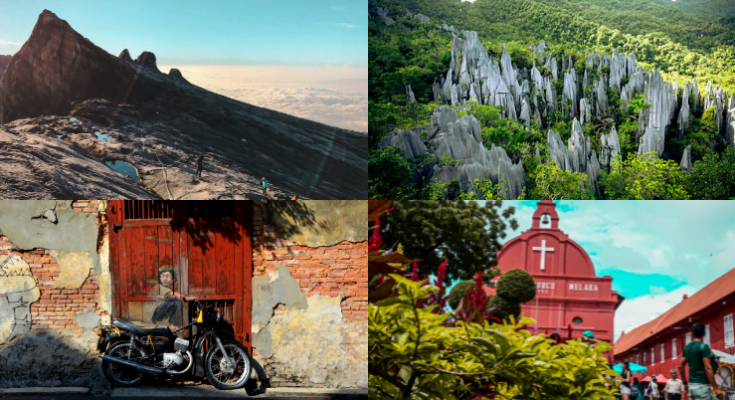Malaysia is home to a melting pot of cultures and amazing natural flora and fauna, hence it’s no doubt that Malaysia is home to four UNESCO World Heritage Sites with more to be announced soon.
What Is A UNESCO World Heritage Site
The United Nations Educational, Scientific and Cultural Organization (UNESCO) designates World Heritage Sites of outstanding universal value to cultural or natural heritage which have been nominated by countries which are signatories to the UNESCO World Heritage Convention, established in 1972.
Cultural heritage consists of monuments (such as architectural works, monumental sculptures, or inscriptions), groups of buildings, and sites (including archaeological sites). Natural features (consisting of physical and biological formations), geological and physiographical formations (including habitats of threatened species of animals and plants), and natural sites which are important from the point of view of science, conservation or natural beauty, are defined as natural heritage.
Malaysia has four sites on the list where the two sites listed in 2000 are natural and the other two are cultural. In addition, Malaysia has six sites on its tentative list.
1) Kinabalu Park, Sabah
Photo Credit: Ling Tang on Unsplash
This place is not only home to Malaysia’s tallest mountain, Mount Kinabalu but also recognised as one of Malaysia’s natural UNESCO World Heritage site in 2000. This landmark in Sabah is sprawled across 75,370 hectares of tropical rainforest, 93 percent of which is still virgin.
This location is renowned for having an extraordinary, 15 million-year-old, naturally functioning environment. 1,000 species of orchids, 78 species of ficus, 60 species of ferns, and 326 species of birds are also to be found here.
- Book a scenic tour at Kinabalu Park, Sabah by clicking here.
2) Gunung Mulu National Park, Sarawak
Photo Credit: zodebala
The vast 52,860 hectare (528.64 sqkm) Gunung Mulu National Park in Sarawak is located in the interior of the island of Borneo. With 295 km of caves that have been explored, it is the most researched tropical karst region on earth and the park is also home to the Sarawak Chamber, which is the largest cave chamber in the world.
The eerie white and upright limestone pinnacles at Mount Api are the site’s most recognisable and obvious feature. This location is a veritable ecological treasure trove with many interesting things being discovered here, such as 20,000 kinds of invertebrates, 87 species of mammals, 8 species of hornbills, 28 species of bats, 25 species of snakes, 270 species of birds, and 55 species of reptiles.
- Book a stay at the Mulu Marriott Resort by clicking here.
3) Melaka and George Town, Historic Cities of the Straits of Malacca
Photo Credit: Hao Pan on Unsplash
Two well-known tourist destinations in Malaysia, Melaka and George Town are well recognised for their history and culture as it comprises two important colonial cities at the Strait of Malacca, an important trade route connecting China with Europe, Middle East, and the Indian subcontinent.
Melaka has all the necessary components for a melting pot of history and culture thanks to the influence of the Portuguese, Dutch, English, early Chinese, and locals. A Straits Chinese or Peranakan community known as “Baba Nyonya,” which is still present and exclusive to Melaka, was created due to intermarriage between the indigenous Malays and the Chinese traders in the fifteenth century. This heritage of cultural and historical medley can be seen in religious buildings, streets, markets and even food.
Photo Credit: Aaron Lee on Unsplash
On the other hand, culture seekers go to George Town in quest of the many still-existing, century-old streets that crisscross the town and are dotted with intricately restored colonial shop facades. The public has always been motivated by conservation since it fosters economic activity and guarantees that the town will continue to be a treasure.
- Go on a historical tour in Melaka with lunch provided by clicking here.
- Experience George Town through a heritage tour by clicking here.
4) Lenggong Valley, Perak
Photo Credit: lokalocal
The latest one added to the UNESCO list in 2012, Lenggong Valley contains two clusters of archaeological sites that cover one of the longest culture sequences in a single locality in the world.
This exceptional Palaeolithic site, which spans 399 hectares and is located along the Perak River valley, is thought to be dated back 2 million years ago and is the oldest place outside of Africa where early humans have been discovered in a single region. Perak Man, discovered in one of the caves, is the oldest and most complete human skeleton in the region and was dated to be about 10 000 years old.
- Enjoy a day tour to Kuala Kangsar & Lenggong Valley by clicking here.
- Click here for exclusive Shopee cashback vouchers.
- Follow us on our Facebook and Instagram for more updates and the latest happenings around Malaysia.
Feature Photo Credit: Sandip Roy on Unsplash, zodebala, T RR on Unsplash, Ling Tang on Unsplash




